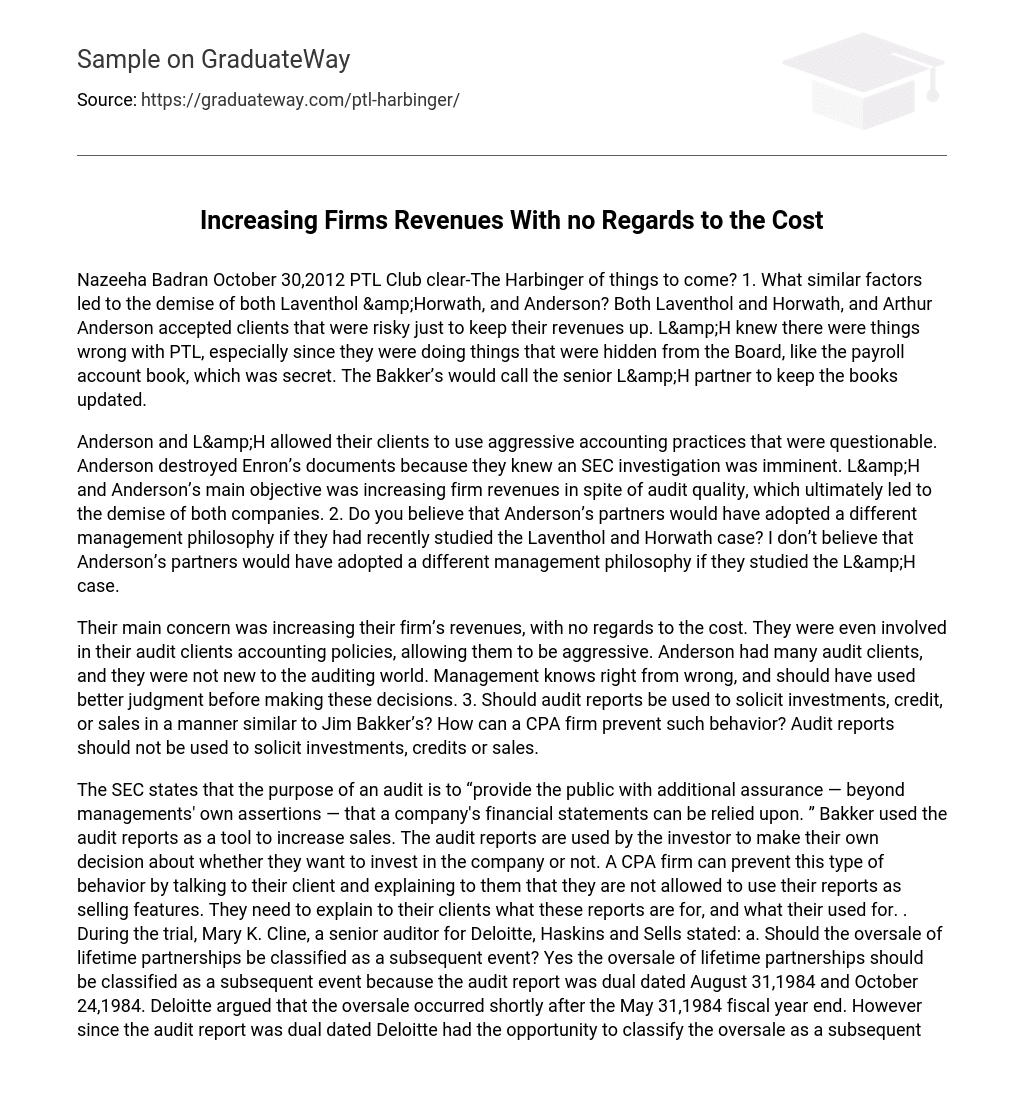- What similar factors led to the demise of both Laventhol &Horwath, and Anderson? Both Laventhol and Horwath, and Arthur Anderson accepted clients that were risky just to keep their revenues up. L&H knew there were things wrong with PTL, especially since they were doing things that were hidden from the Board, like the payroll account book, which was secret. The Bakker’s would call the senior L&H partner to keep the books updated. Anderson and L&H allowed their clients to use aggressive accounting practices that were questionable. Anderson destroyed Enron’s documents because they knew an SEC investigation was imminent. L&H and Anderson’s main objective was increasing firm revenues in spite of audit quality, which ultimately led to the demise of both companies.
- Do you believe that Anderson’s partners would have adopted a different management philosophy if they had recently studied the Laventhol and Horwath case? I don’t believe that Anderson’s partners would have adopted a different management philosophy if they studied the L&H case. Their main concern was increasing their firm’s revenues, with no regards to the cost. They were even involved in their audit clients accounting policies, allowing them to be aggressive. Anderson had many audit clients, and they were not new to the auditing world. Management knows right from wrong, and should have used better judgment before making these decisions.
- Should audit reports be used to solicit investments, credit, or sales in a manner similar to Jim Bakker’s? How can a CPA firm prevent such behavior? Audit reports should not be used to solicit investments, credits or sales. The SEC states that the purpose of an audit is to “provide the public with additional assurance — beyond managements’ own assertions — that a company’s financial statements can be relied upon. ” Bakker used the audit reports as a tool to increase sales. The audit reports are used by the investor to make their own decision about whether they want to invest in the company or not. A CPA firm can prevent this type of behavior by talking to their client and explaining to them that they are not allowed to use their reports as selling features. They need to explain to their clients what these reports are for, and what their used for.
- Why do you think audit firms are willing to accept high-risk clients? Audit firms are willing to accept high-risk clients in order to increase their revenues.
- What analytical and audit procedures could have led to Deloitte and L&H to have more easily detected and reported PTL club’s financial problems? Deloitte and L&H should have compared PTL’s financial statements from one year to the next. They should have calculated financial ratios to see their ability to pay off their debts and how much their liabilities are. They should have also examined PTL’s lifetime membership amounts and how reasonable it is to fulfill their membership promises.
- Why would a staff auditor want to be a “part of the client’s team” and consent to questionable practices rather than being an “independent watchdog” and contest such practices? A staff auditor would want to be a part of the client’s team in order to fit in. The staff auditor would consent to questionable practices because they are afraid to ask questions, and get the client angry at them. The staff auditor may not want to seem stupid for asking a question. The auditor could be scared to get a negative review of their work if they ask too many detailed questions.
- How could the auditors have known and understood the PTL business better in order to audit more efficiently and effectively? Auditors should have researched the industry thoroughly. They should have asked management and employees questions regarding how the business operates. They should have observed the company employees and their actions. They should have understood how the business operates, and what roles everybody had to efficiently and effectively audit the company.
- Is it the auditor’s responsibility to verify that the clients meet tax-exempt status? It is the auditor’s responsibility to verify that the clients meet tax-exempt status. The auditor’s responsibility is to verify that the financial statements are not materially misstated. However if the client did not meet the tax-exempt status, that creates a tax liability on the client, as PTL did. Paying the tax liability would decrease income, which would change the financial statements. In order to certify that the financial statements are not materially misstated it is important to verify that the client meets tax-exempt status.
- Did the preparation of checks violate the auditors Code of Ethics? Yes. Preparation of checks did violate the auditor’s code of Ethics. They are supposed to be independent in both appearance and fact. Writing checks is the Clients job, not the auditors. The auditors also wrote the checks from a secret account to the Bakker’s and other employees. The auditors should be independent. Their job is to certify that the financial statements are free of material misstatement. They are not supposed to be involved in daily tasks that are PTL’s responsibility. It seems like the auditors were working in the client’s best interest not the public who are relying on the accuracy of the financial statements. This is definitely a conflict of interest on the auditor’s side.
Increasing Firms Revenues With no Regards to the Cost
Cite this page
Increasing Firms Revenues With no Regards to the Cost. (2016, Dec 09). Retrieved from
https://graduateway.com/ptl-harbinger/





